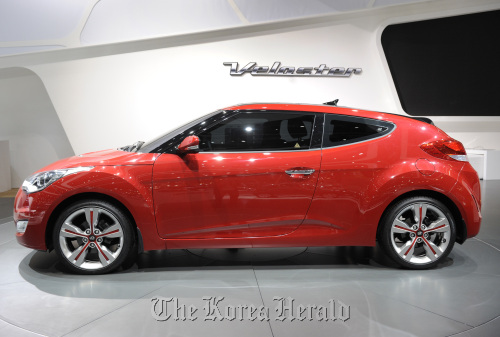Hyundai Motor Co.’s bet on edgier styling to distinguish its vehicles from competitors has paid off with two straight years of record U.S. sales. Building on those gains is about to get tougher.
Emboldened by the success of cars such as the Elantra and Sonata that helped lure customers from Toyota Motor Corp. and Honda Motor Co., Hyundai is now gambling on the three-door Veloster and six-cylinder Azera. The decision to craft a strategy around distinctive design still has the legs to further boost market share well beyond next year, said John Krafcik, chief executive officer of the Seoul-based company’s U.S. unit.
“We have demand in excess of our ability to supply, for almost all of our models right now,” Krafcik, 50, said in an interview in Portland, Oregon. “With the Veloster and especially with the Azera, you’re really going to see this focus on design pay off.”
Hyundai’s share of U.S. sales has risen 0.5 percentage point in the past year to 5.2 percent in August, according to Autodata Corp. Toyota has dropped 2.5 percentage points to 12.7 percent, while Honda is down 1.5 percentage point after the Japanese earthquake in March disrupted their supply chains and limited inventory. Both are returning to full production, with Toyota set to begin sales this month of a revamped Camry sedan, and Honda increasing output of its new Civic compact.

Hyundai Motor’s Veloster (Bloomberg)
“The rest of the year may not be as earth-shattering as the beginning has been” for Hyundai, said Jessica Caldwell, a senior industry analyst with Edmunds.com in Santa Monica, California. Honda and Toyota “will be more aggressive in the final months of the year.”
Krafcik said he’s not concerned.
“People will always say ‘you guys got lucky because competitors had to deal with this other thing,’” he said referring to the earthquake-related disruptions. “Even without those issues, we still think our share of demand would be higher than our actual ability to deliver the volume.”
Hyundai in large part is counting on more converts like Lorraine Cagliostro, an interior designer from Hunterdon, New Jersey, who bought a 2011 Sonata Sport last year after being disappointed by “faux luxury models” she had owned including a Mercedes-Benz C-Class sedan and Nissan Motor Co. Infiniti FX.
“I’m really blown away by this car,” she said of the Sonata. Hyundai has “proven you do not need to spend $40,000, $50,000, $60,000 to buy a car that drives and handles really well,” said Cagliostro, whose husband plans to get an Elantra.
The Veloster, a low-slung, three-door hatchback styled like a compact coupe, goes on sale this month, aimed at buyers in their 20s. The 2012 Azera, a large sedan with a six-cylinder engine, arrives late this year to appeal to drivers of Toyota’s Avalon and full-size cars from U.S.-based competitors.
Those models and a revamped Santa Fe sport-utility vehicle will complement demand for the Sonata, Elantra, Tucson and Accent small cars as well as luxury Equus sedans, ensuring further gains in 2012, said Krafcik, who declined to provide volume goals.
About 17 percent of U.S. consumers in the market for a new vehicle would “definitely” consider buying a Hyundai product, said Alexander Edwards, president of Strategic Vision Inc., a San Diego-based research firm that surveys 300,000 people a year for its automotive studies. While that’s about the industry average, and trails Toyota’s and Honda’s 40 percent, it’s up from about 1 percent a decade ago, he said.
“The important point is they are rising steadily,” Edwards said. “We do not yet see the extent of Hyundai’s opportunities to grow in the U.S.”
Hyundai was among just three carmakers, along with affiliate Kia Motors Corp. and Fuji Heavy Industries Ltd.’s Subaru, to boost U.S. sales in 2009 as industrywide demand plunged amid the recession and bankruptcies at the predecessor companies of General Motors Co. and Chrysler Group LLC. From 2008 to 2010, Hyundai’s U.S. sales grew 34 percent.
With sales up 21 percent this year through August, Hyundai may sell more than 650,000 cars and light trucks to U.S. customers in 2011. Kia, which shares engines, vehicle platforms and a chairman with Hyundai, may sell 450,000 vehicles in the U.S. That would be the first time combined sales for the partners, which operate separately in the U.S., top 1 million.
Toyota’s U.S. sales are down 7.8 percent so far this year and Honda’s have slid 5.5 percent.
The revamp of the Camry, the best-selling car in the U.S., may give Toyota a boost and and slow Hyundai’s pace in the fourth quarter, Caldwell said. Honda’s resumption of full North American production and increased output of the Civic compact in the final months of 2011 will also boost competition, she said.
“Also, Hyundai has become a more mainstream brand, so people are expecting more good things from them,” she said. “It gets a bit harder to keep meeting those expectations.”
Krafcik, who began his automotive career in the early 1980s as an engineer at a former Toyota-General Motors joint-venture plant in California, said Hyundai is both “paranoid” about competition and secure in its strategy.
“One of the things I think our competitors need to worry about is that some of the stuff they have coming in the next year or two was designed three or four years ago,” he said. “If they really haven’t stretched on design, it’s going to be really hard to battle back.”
(Bloomberg)





![[KH Explains] How should Korea adjust its trade defenses against Chinese EVs?](http://res.heraldm.com/phpwas/restmb_idxmake.php?idx=645&simg=/content/image/2024/04/15/20240415050562_0.jpg&u=20240415144419)
